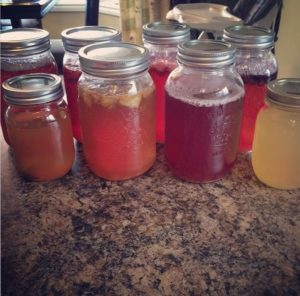
Kombucha is one of our favorite drinks. Not only does it taste good, it is good for you! I am far from an expert on the topic, but want to share the information that I have learned.
What is kombucha?
Kombucha is a fermented beverage made using tea, sugar & a SCOBY. It contains b-vitamins, antioxidants, probiotics & beneficial acids.
What is a SCOBY?
SCOBY is an acronym for symbiotic culture of bacteria and yeast. It is a mass of beneficial bacteria and yeast that work together to ferment sweet tea. A SCOBY is also called a “mother”. As the “mother” works to ferment the sweet tea, a new “baby” SCOBY will form a layer on top to protect the brew.
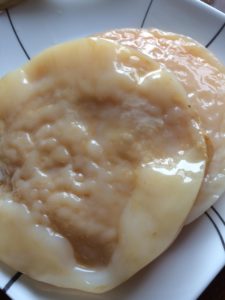
What are the benefits of kombucha?
Though kombucha has been around for thousands of years, there have been few studies done on the benefits of it.
Many claims have been made that it:
- Improves digestion
- Boosts energy
- Strengthens the immune system
- Detoxifies the body
We personally feel better when we drink it, and know others who swear by it as well.
Kombucha is widely available in health food stores and grocery stores, but it is pretty pricey ($4-6 per bottle). A better way to get all the benefits without the steep price tag is to make your own.
I will admit, I was a little scared and overwhelmed with the thought of brewing my own, but after I took the plunge, I realized how easy it really is!
When we made the move to the farm, I left my brew and my SCOBY hotel (storage for extra SCOBYs) on a shelf in my parents’ basement for a couple months. Though the brew had definitely gone too long for us to drink it (after a long fermentation, the brew turns to vinegar), it worked great as a starter for my next batch when we got settled and my SCOBYs also survived. The vinegar can also be used as a replacement for other vinegars in recipes such as salad dressings or for cleaning.
After the initial fermentation that typically takes 7-10 days, you can bottle the kombucha and drink it as is, or what we prefer, is to bottle it with some fruit (or fruit juice) for a 2nd ferment (2-7 days), which creates a fizzy pop-like beverage.
What you need:
For one gallon of kombucha:
- 8 tea bags (I use organic green tea)
- 1 cup of sugar (I use organic cane sugar)
- 1 gallon size glass jar
- 1 SCOBY
- 1 cup of starter tea (kombucha from a previous batch)
- Cover for the jar and elastic band (I use a thin dish cloth; I used to use cheesecloth, but after doing more research, I realized that kombucha can attract fruit flies and they can still get into the brew through the cheesecloth)
What you do:
The first step is to prepare the sweet tea. I bring 1 gallon of water to a boil and then remove from the heat and stir in 1 cup of organic cane sugar until it is dissolved. Then I add in my 8 tea bags. After the tea has steeped for as long as indicated in the package, I remove the tea bags and let the tea cool completely. This step is extremely important, as it can kill your SCOBY if it is too hot. I usually make my tea in the evening and put a lid on it to cool over night.
Make sure your hands are very clean! Pour the cooled sweet tea into a very clean 1 gallon glass jar, leaving a couple inches of room at the top. Add the 1 cup of starter from your previous batch, then place your SCOBY on top. It may float or sink, either is fine, as a new SCOBY will eventually grow on top to protect your brew.
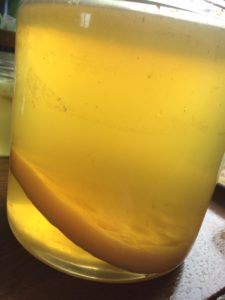
Cover the brew with your cloth and secure with an elastic band.
Move the jar to a warm corner of your kitchen, out of direct sunlight, where it won’t be disturbed. I put mine on a shelf in the pantry. If your room is a bit cooler, it will take longer for fermentation to occur. You also want to make sure that if you are fermenting other things (kefir, saurkraut, etc) that you keep the kombucha a few feet away to prevent cross-contamination of the cultures.
Let the brew sit for 7-10 days. You can start to taste it on day 7 and each day after to determine when it is ready. You will be able to tell because it will be more tart than sweet. By tasting it every day you will be able to notice the change.
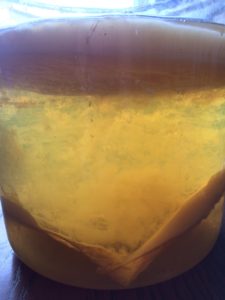
Always make sure you keep 1 cup of from your previous batch as a starter for the next batch.
Once it is ready, you can pour it into mason jars or bottles and put in the fridge to drink as is or do 2nd ferment.
2nd Ferment
By doing a 2nd ferment, you can turn your kombucha into a fizzy, pop-like beverage. I do this in mason jars, but have heard you can use flip top bottles to get even more fizz.
All you have to do is pour the fruit into the jars (I use 1/4 cup for a pint and 1/2 cup for a quart) and then fill them up with kombucha, leaving a bit of space at the top. Then, screw the lid on tight and leave sit on the counter for 2-7 days until it has as much fizz as you would like. Remove the fruit with a clean stainless steel spoon or nylon strainer, as plastic or other metals can react negatively with the kombucha. The nylon strainer that I use can be found here. Once the fruit has been removed, place the lids back on the jars and move to fridge. The fruit can be used in smoothies, as yogurt topping, in fruit snacks, or even as a treat for your chickens. I just use whatever fruit I have in the fridge or freezer. Some of our favorite flavors are Saskatoon & raspberry. Fresh picked berries in the summer time are best!
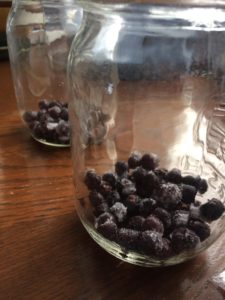
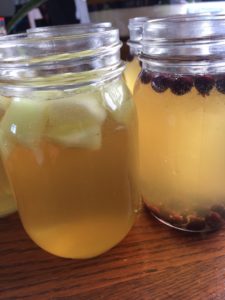
Have you made made kombucha? What is your favorite flavour?
If you have any questions, make sure to leave a comment below!
-Cassandra
[yumprint-recipe id=’3′]